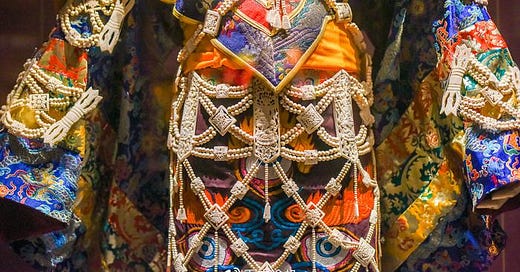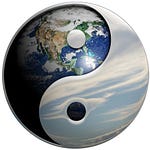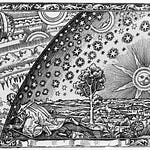Content note: Traditional religious artworks featuring nudity, death imagery, and body horror. Possibly not safe for work, or life.
The video includes those as illustrations. Without them, listening to the audio alone may be difficult to understand. Watch full-screen for maximum impact.
Context and explanation
The audio is extracted from a two-hour recorded conversation between
and . Overall, it was about David’s mixed feelings about his edgier posts (“You should be a God-Emperor” and “The Piss Test”) being unusually popular. There’s an unwanted possibility of “audience capture” directing him toward producing sensationalistic clickbait, and he asked Charlie for advice about this. We’ll post more from that discussion Real Soon Now.Ironically, this video may be even edgier. Nevertheless, as David said to Charlie, “I just explain things I find interesting, and some get taken as controversial.”
At one point, our meandering conversation turned to the role of dress in Vajrayana. That is an important part of Buddhist tantric practice—and this extract is about that.
“You should be a God-Emperor” discussed briefly the abhisheka ritual (“empowerment”; wang in Tibetan):
In scriptural theory, abhisheka forcibly transforms your self into a yidam by putting you in extremely unusual circumstances. As originally performed, the ritual combined the imperial coronation ceremony of the Pala Empire—you are crowned as a god—with the transgressive sex and death magic of outcaste witches. It was utterly over the top, shredded any sense of ordinary self, and replaced that with the enlightened self of the yidam.
This video explains one small aspect of the ritual as it is sometimes performed in the traditional way: dancing in ornaments made from human bones. When maximally traditional, those are worn without other clothing.
One aspect of dress in Vajrayana is elegance, vivid display, as a manifestation of the enlightened quality of the Ratna Family of buddhas. Tantra transforms acquisitive greed into the wish that everyone should experience beauty. Splendid dress can be a way of providing that visual experience for others. You’ll see some examples of that in the video, but it wasn’t our main topic.
Another aspect is the way that “clothes make the person”—and make the tantrika, and make the buddha. Each buddha is always shown with the same clothing, the same ornaments and accoutrements, which express the unique character of their enlightenment.
Ordained tantrikas wear particular robes and ornaments that are different from those worn by monks. You can see an example right at the end of the video. After the end of this extracted clip, we discussed those at some length, particularly regarding Charlie’s experience of wearing them when ordained. David kept interrupting, so that part of the audio is a mess and isn’t included here.
Wearing the human bone ornaments is a way of stepping into a radically different way of being. Charlie explained that this is true of any form of dress. It’s particularly true of ones that are formally specified for a purpose. Putting on a firefighter’s outfit, or a business suit, shifts you into the corresponding ways of being. An excerpt from our discussion that’s not included in the video:
David: You said something I wasn't particularly aware of, that my way of being changed significantly when I wore a business suit.
Charlie: I remember getting off a plane and seeing this apparition walking towards me, very well dressed, with absolute confidence of movement and expression and a sense of dignity and grandeur that was just very natural at the same time. And I thought, who the !@#$ is that? There was something that changed about your whole demeanor just by being in that business suit. And it wasn't that you were putting on any affect at all. And it wasn't just the suit, it was that you changed how you stood.
I think people will be able to relate to this, that when you dress up, you carry yourself differently. If you're not used to that, and if you're not used to being in a context where that is invited, then it could feel very fake and you could feel kind of awkward or embarrassed or like you're being pretentious. I've spoken to a lot of students and people I coach who have had that kind of experience.
And then after a while it becomes more familiar and you come to feel okay in it and like, “Oh, I can actually be this person who goes about the world in this way.”
There’s a photo of Narendra Modi and Vladimir Putin in suits near the end of the video. If you look closely, you’ll see that Modi is wearing a Jodhpuri, which is a modern adaptation of ancient Indian royal court attire. We imagine that the meeting might have gone differently if they had been wearing T-shirts and running shorts, and differently again if they had been wearing the religious regalia of high-ranking clerics from their respective cultures.
Right at the end of the video, Charlie makes a significant point about the nature of Buddhist tantra that would be easy to miss. The form of the outfit is “externally provided.”
Buddhist tantra is not about self-expression. It aims to transcend any fixed, limiting way of selfing, of being in the world, leaving behind (temporarily at least) your habitual self. That is the point of yidam practice—of becoming a god-emperor, a goddess with a lioness’ head, a necrophiliac witch, a voluntary human sacrifice, or a naked blue man who is awareness itself and the origin of all phenomena.
To do that, you follow the given form of the ritual. This is not rigid conformity for its own sake. The principle is that if you make something up yourself, it will be an imaginative extension of your habitual self. That may be valuable—but it does not provide the same value as inhabiting a way of being that is radically alien.
Transcript
Charlie: What experience are you thinking of?
David: There’s what’s called the human cemetery bone ornaments in tantra.
Charlie: Oh yeah!
David: And if you look at thangkas, which are the religious icon paintings, very often the yidams will be wearing these strings of beads that are crisscrossed in a kind of argyle pattern. And, sometimes they’re naked yidams wearing the… just, I mean, sometimes yidams are just straight up naked, which usually is a symbol of Dzogchen. The human cemetery bone ornaments are a specifically tantric symbol, and sometimes those are worn over robes, which is some kind of, you know, monastic decorum, you know, we don’t want to show our genitals in public or something, but normally—
Charlie: What do you mean, “normally”? How it used to be in, in the old days?
David: In the good old days! Anyway. The yidams are often shown wearing these bone ornaments, so they’re worn in some ritual occasions, in empowerments where it’s a small closed group of apprentices who will reliably not have strong emotional reactions to things that are not necessary to have strong emotional reactions to.
Bone ornaments are worn naked and it’s usually an ordained person. There are ordained people who have specific roles in the ritual who wear the human cemetery bone ornaments specifically to indicate that role.
I was never ordained, but there was one occasion when— there are roles specifically for men in the empowerment ritual. And there was— there were only two ordained men and three are required, so I got drafted. So that was the one time I have worn the human bone ornaments.
And it was an absolutely extraordinary experience, in some way that I can’t articulate, but it’s just this sense of moving into the visionary realm, because this is not something that anybody does unless you’re moving into the visionary realm, and nobody would understand the meaning of this unless they were deeply steeped in tantra.
Although, you know, there’s a certain kind of shock value to it that is part of the function, but the other part of the function, I think, is the connection with the whole lineage of death ritual and, going back to the dakinis, of charnel ground practice where you’re practicing in a literal charnel ground, where there’s human bones scattered around, and so if you want to make ornaments, what are the available materials? Well, there’s human bones. All right, we’ll make—
Charlie: Yes, and there’s something about wearing death draped around your body that is an extraordinary experience in itself. What you don’t realize until you’re actually in that experience is how heavy they freaking are. They are so heavy. And so you’re actually walking around with this weight and the sense of the weight of death is unavoidable. It’s visceral and you’re moving. And there is a function to being in that experience of wearing the human bones as well, that is highly pertinent to the particular ritual that you’re involved with.
And they make sound, like, they’re banging against each other, they’re clacking against each other. And they’re, you know, the weight you’ve got them on your head as well. They’re, they’re pressing down on your head, and they’re like cuffed. So they’re like bonds. They’re cuffed around your wrists and your ankles. I had a set of bone ornaments because I was an ordained tantrika, and so I would wear my bones and there’s a lot of them. You wear them over your entire body and they’re very heavy and clacking and moving as you move.
So there’s this visceral feeling of: you are the moving piece in the ritual. And you are inside of death. You’re death moving in and amongst the people who are sitting very still, in the wang, the empowerment that we’ve spoken about before.
That is particularly tantric and it probably encapsulates the idea of stepping into, simply stepping out of an ordinary way of being and instantaneously stepping into a different way of being. And that way of being is externally provided. It’s a structure, very literally in that sense, it’s a literal structure that you step into.
That’s the same with clothes, with dress, with any costume that you step into. You’re stepping into a structure that is externally provided such that you can manifest the way of being that is suggested by the texture, the color, the particular formality of it, the feel, the look, the style, everything about it is suggesting a manner or a demeanor or a way of being.
And so you can simply become that, and much tantric ritual is like that.
















Share this post